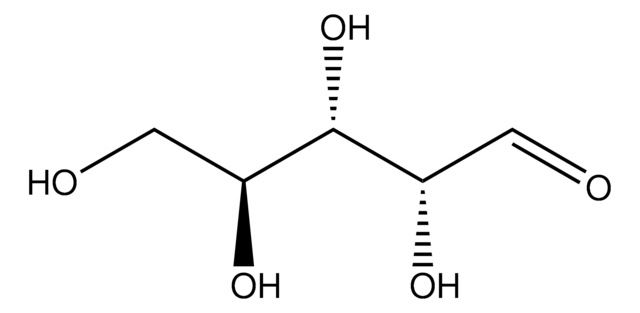63579
D-(+)-mannosio
BioUltra, ≥99.5% (sum of enantiomers, HPLC)
Sinonimo/i:
D-mannopiranosio
About This Item
Prodotti consigliati
Nome Commerciale
BioUltra
Saggio
≥99.5% (sum of enantiomers, HPLC)
Stato
solid
Attività ottica
[α]20/D +13.8±0.5°, 24 hr, c = 10% in H2O
Impurezze
insoluble matter, passes filter test
Residuo alla calcinazione
≤0.1% (as SO4)
Perdita
≤0.1% loss on drying, 20 °C (HV)
Colore
white
Punto di fusione
133-140 °C (lit.)
Solubilità
H2O: 1 M, clear, colorless
Anioni in tracce
chloride (Cl-): ≤50 mg/kg
sulfate (SO42-): ≤200 mg/kg
Cationi in tracce
Al: ≤5 mg/kg
As: ≤0.5 mg/kg
Ba: ≤5 mg/kg
Bi: ≤5 mg/kg
Ca: ≤200 mg/kg
Cd: ≤5 mg/kg
Co: ≤5 mg/kg
Cr: ≤5 mg/kg
Cu: ≤5 mg/kg
Fe: ≤5 mg/kg
K: ≤50 mg/kg
Li: ≤5 mg/kg
Mg: ≤20 mg/kg
Mn: ≤5 mg/kg
Mo: ≤5 mg/kg
Na: ≤50 mg/kg
Ni: ≤5 mg/kg
Pb: ≤5 mg/kg
Sr: ≤5 mg/kg
Zn: ≤5 mg/kg
λ
1 M in H2O
Assorbanza UV
λ: 260 nm Amax: 0.1
λ: 280 nm Amax: 0.1
Temperatura di conservazione
room temp
Stringa SMILE
OC[C@H]1OC(O)[C@@H](O)[C@@H](O)[C@@H]1O
InChI
1S/C6H12O6/c7-1-2-3(8)4(9)5(10)6(11)12-2/h2-11H,1H2/t2-,3-,4+,5+,6?/m1/s1
WQZGKKKJIJFFOK-QTVWNMPRSA-N
Cerchi prodotti simili? Visita Guida al confronto tra prodotti
Applicazioni
Azioni biochim/fisiol
Altre note
Codice della classe di stoccaggio
11 - Combustible Solids
Classe di pericolosità dell'acqua (WGK)
WGK 1
Punto d’infiammabilità (°F)
Not applicable
Punto d’infiammabilità (°C)
Not applicable
Dispositivi di protezione individuale
Eyeshields, Gloves, type N95 (US)
Scegli una delle versioni più recenti:
Possiedi già questo prodotto?
I documenti relativi ai prodotti acquistati recentemente sono disponibili nell’Archivio dei documenti.
I clienti hanno visto anche
Il team dei nostri ricercatori vanta grande esperienza in tutte le aree della ricerca quali Life Science, scienza dei materiali, sintesi chimica, cromatografia, discipline analitiche, ecc..
Contatta l'Assistenza Tecnica.






